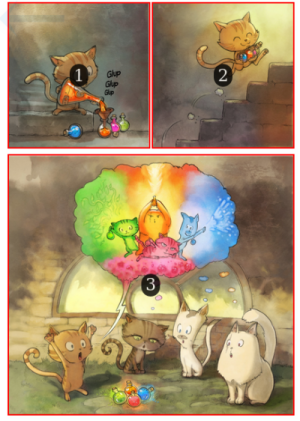Kumiko mascot by Cthulhulumaid, CC-BY-SA 4.0
Kumiko, the Comics Cutter is a set of tools to compute useful information about comic book pages, panels, and more. Its main strength is to find out the locations of panels within a comic's page (image file). Kumiko can also compile information about panels for all pages in a comic book, and present it as one piece of data (JSON-formatted object).
Kumiko makes use of the great (freely licensed) opencv library, which provides image processing algorithms of all sorts. Mainly, the contour detection algorithm is used to detect panels within an image.
TL;WR Too Long; Won't Read the whole doc?
Try reading an xkcd episode panel by panel. :)
Kumiko aims at being a functional library to extract information from comic pages / books. The goal is to provide a set of tools that is usable beforehand, to extract all needed information.
External programs can later use the generated information for different purposes: panel-by-panel viewing, actual splitting of an image down into panels, etc.
Being able to jump from one panel to the next was the original idea behind Kumiko.
xkcd by Randall Munroe, #208, CC BY-NC 2.5
Comic viewers usually imply a very common page-by-page reading paradigm. You read a page, possibly zooming on it to be able to read speech bubbles, then click, tap, press a key or swipe to go to the next page.
With knowledge about panels locations, we can imagine a comic reader that also offers panel-by-panel reading. This is especially interesting for small screens, on which you probably can't read the texts if a whole page is displayed.
We provide an example implementation of such an reader application. Read more in the example Reader documentation.
apt-get install python-opencv will install the only necessary library needed: opencv (2.x).
This should do the trick for Debian distros and derivatives (Ubuntu, Linux Mint...). If you successfully use Kumiko on any other platform, please let us know!
From memory (TODO: check), this implies using python version 2.x, since opencv 3.x runs on python 3.x.
See the usage doc for details on how to use the Kumiko tools.
The numbering is left to right, top to bottom for now (see roadmap).
Here is an example of how Kumiko is going to number panels by default (numbers and red lines not in the original picture).
For now, Kumiko only deals with white-ish backgrounds. Panels within a comic page will be any "object" that has non-white boundaries (not necessarily vertical or horizontal lines).
If you have ideas on how to programmatically guess the background color of a page, please let us know!
- be able to detect panel contours on pages with non-white background
- implies being able to determine the background color: histogram, probing of some kind? (worst case: manually?)
- provide an option for right-to-left numbering, critical e.g. for mangas
Let's face it: we probably can't ensure that Kumiko can perfectly find out the panels in any image. There is a huge diversity of panel boundaries, layouts and whatnot.
This is why we should have some kind of back-office / editing tool that lets a human editor:
- validate pages
- add, delete, move or resize incorrect panels
- report bugs
- ...
Such a tool should edit the JSON file representing a comic book information, for later use by other programs that'll rely on it.


